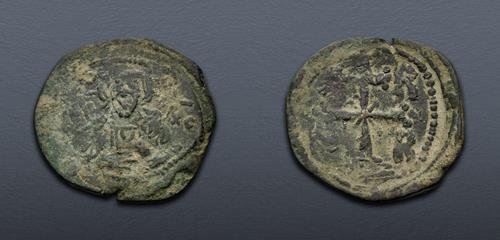
|
Nicephorus Basilacius. Usurper, 1078. Æ Follis (29.5mm, 7.02 g, 6h). Thessalonica mint. Fine.
Electronic Auction 535
Lot: 635. Estimated: $ 500
Byzantine, Bronze
Sold For $ 500. This amount does not include the buyer’s fee.
Go to Live
|
|
Nicephorus Basilacius. Usurper, 1078. Æ Follis (29.5mm, 7.02 g, 6h). Thessalonica mint. Facing bust of Christ Pantokraotr / Jeweled patriarchal cross with central X and four pellets at the end of each extremity; [C] / [N] - B / B in quarters across field. DOC 2c (Nicephorus Bryennius); SB 1890. Earthen green-brown patina. Fine. Rare.
From the Gasvoda Collection. Ex Classical Numismatic Group Electronic Auction 492 (26 May 2021), lot 514.
AD 1078 was a tumultuous year in the Byzantine world. It opened with the latter days of the rule of Emperor Michael VII Ducas, and ended with Nicephorus III Botaniates in power. But Nicephorus Botaniates’ revolt against Michael was not the only revolt of 1078; rather, it was not even the only revolt to feature a general by the name of Nicephorus. To further muddy the waters of coinage in 1078, Nicephorus Basilacius and Nicephorus Bryennius also revolted in the same time period.
While still in the service of Emperor Michael VII, Nicephorus Basilacius was dispatched in October 1077 to deal with the rebelling Duke of Durazzo, Nicephorus Bryennius. Although Basilacius put little effort into attempting to quell the revolt which was gripping most of the provinces of Macedonia and Thrace, he did in the process occupy Thessalonica, thereby denying the important city to Bryennius.
The dynamic changed when Nicephorus Botaniates successfully deposed Michael VII and occupied Constantinople in early April 1078. He subsequently offered the revolting Duke Bryennius the rank of Caesar in an attempt to make peace. But the consolatory prize of second rank was not enough to satiate the aspiring Bryennius who promptly refused the offer. Consequently, the now Emperor Nicephorus III Botaniates dispatched his trusted general, the future emperor Alexius I, to deal with Bryennius. Meanwhile, Basilacius continued to occupy the city of Thessalonica.
Bryennius was defeated in battle by Alexius at Kalavrye in Thrace. His fleeing army was assumed by Basilacius who made his true intentions known by also revolting and declaring himself emperor at Thessalonica. Alexius was subsequently sent by Nicephorus III to Thessalonica to deal with Basilacius. Besieged by Alexius, the citizenry of Thessalonica, evidently weary of the constant stream of revolting Nicephori, gave Basilacius up to Alexius.
These rare folles are attributed to either the rebel Bryennius or Basilacius; a matter complicated due to the similarity of their names. But due to Basilacius’ occupation of Thessalonica, which possessed a mint, some scholars advocate for the attribution of these coins to Basilacius over Byennius.
In the end, while Nicephorus III had successfully deposed Michael VII and defeated his revolting peers and fellow Nicephori, he only ruled for three years.
Unfortunately for him, a fourth Nicephorus appeared on the scene when Nicephorus Melissenus revolted. The apt Nicephorus-defeating general Alexius would prove incapable of relying upon this time as Melissenus was his brother-in-law. Nicephorus III found the situation impossible and abdicated, making way for a new dynasty headed by Alexius—the Comnenian.
Closing Date and Time: 29 March 2023 at 13:31:20 ET.
|
